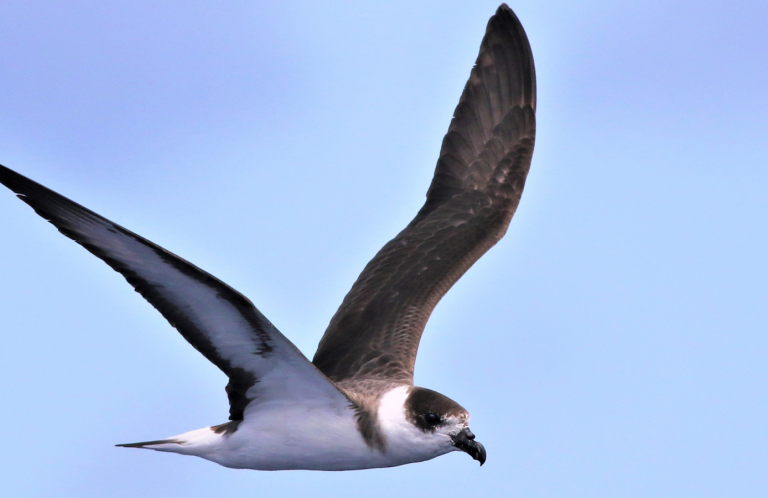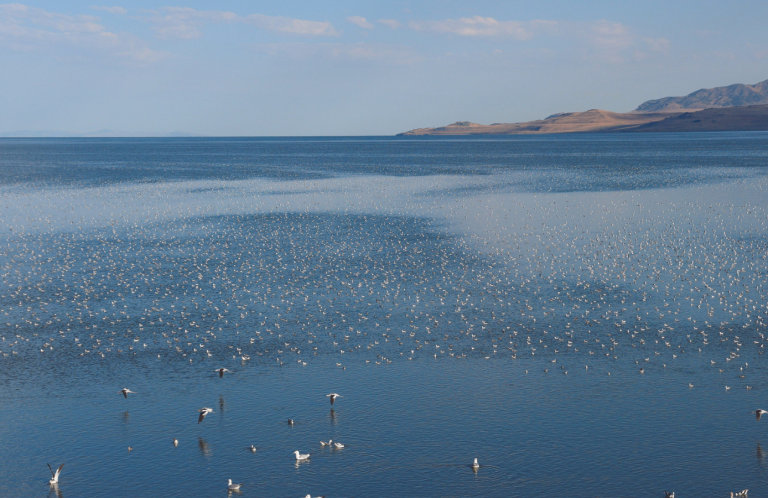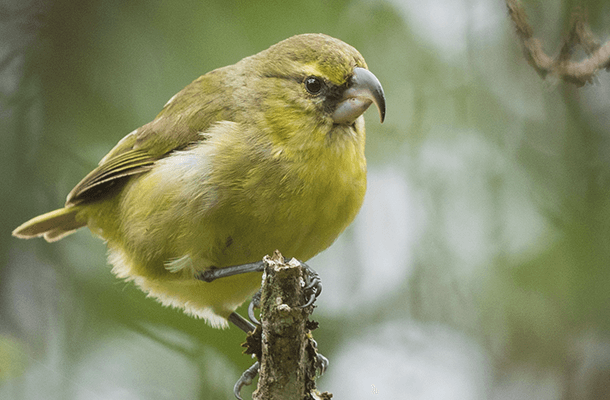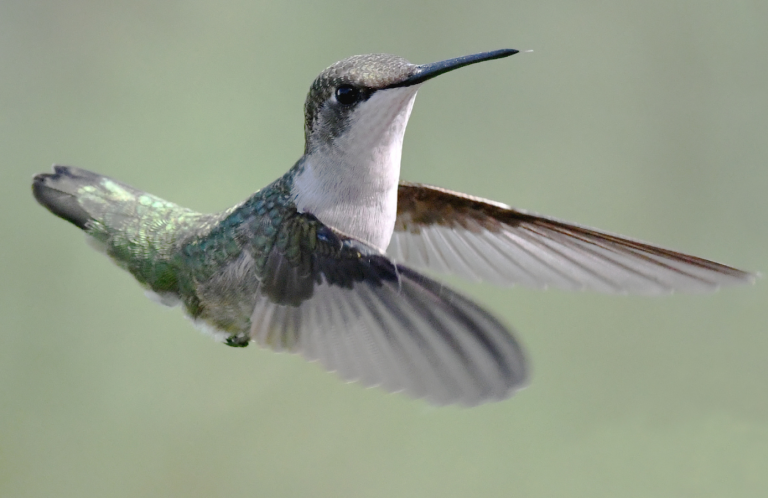From California to Florida, A Push to Make Windows Safer for Birds
Most of us know the signs: a dull thump, a powdery smudge, or a few tiny breast feathers stuck on the glass. A bird has struck our window.
Totaled across tens of millions of residences and larger buildings like office complexes and museums, these collisions add up: Scientists estimate that at least 600 million birds die every year in the United States after colliding with window glass.
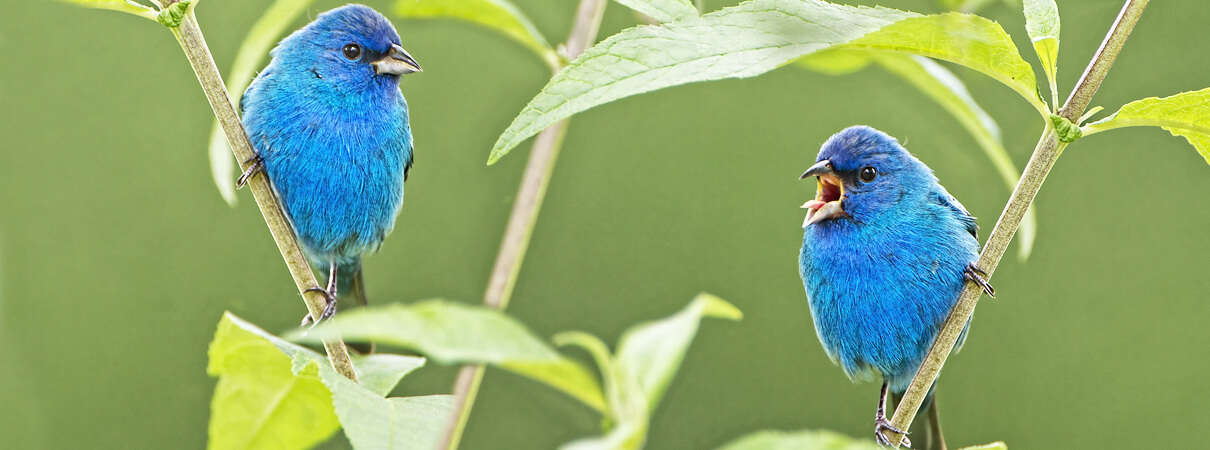
An entire flock of Indigo Buntings flew into a window at NASA's Johnson Space Center in 2012, spurring the Center to take action. Photo by Bonnie Taylor Barry/Shutterstock
Human brains learn that glass is present when we see window frames, specks of dirt, or other cues. We cannot actually see the glass itself. (Anyone who has ever walked into a sliding glass door knows what happens when the brain misses these cues.) Birds, however, don't typically get a chance to learn this trick, because their first collision is often fatal.
As conservationists at American Bird Conservancy (ABC) and elsewhere advocate for greater awareness of the dangers glass windows pose to birds, more and more companies, educational institutions, and government facilities are taking action.
“We're starting to see a real response to our efforts to make people aware of the dangers that glass can pose to birds,” says Christine Sheppard, ABC's Bird Collisions Campaign Director. “People are realizing that with minimal effort, they can make their buildings and homes much safer for birds. There is much more to do, of course, but we are definitely making progress.”
A Gauntlet of Glass
To a bird's eye, when light passes through glass, windows appear to be open passages they can fly through. But when light reflects off of glass it is just as dangerous. Reflective glass mirrors the surrounding environment, presenting birds with inviting vistas of trees and open sky that are anything but safe.
Many factors can influence the likelihood of birds striking a building's windows: nearby vegetation, patterns of bird movements in the surrounding environment, and the reflectivity of the glass. But the strongest predictor of window collisions is simply the amount of glass on the building's exterior.
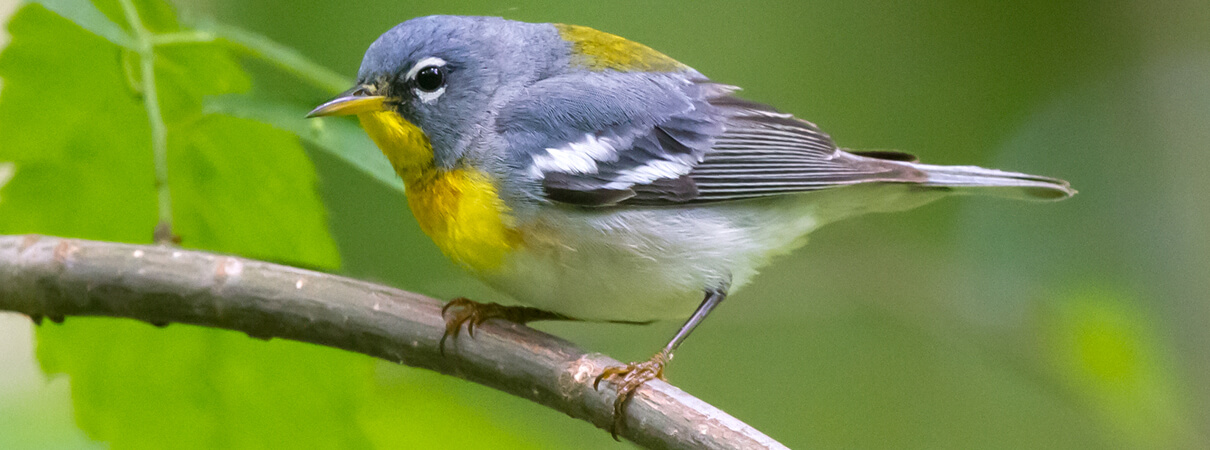
Songbirds like Northern Parula were hitting an overpass at Key West International Airport — a problem that has now been resolved thanks to installation of Solyx Bird Safety Film. Photo by Frode Jacobsen
Luckily, the solution is just as simple. Research has shown that birds are aware of their own body dimensions and, unsurprisingly, they don't attempt to fly into spaces smaller than their height and wingspan. For songbirds — the most frequent victims of window collisions — that magic size appears to be two inches high and four inches wide. (Sheppard calls this the “2 by 4 rule.”) Applying a pattern to glass — with horizontal elements spaced no greater than two inches and vertical elements four inches or less apart — allows most birds to perceive the pattern as a barrier and avoid the glass. Patterns are most effective when they're affixed to the exterior of the glass, where reflections can't obscure them.
These patterns can be surprisingly unobtrusive, inexpensive, and even aesthetically pleasing. Home builders or developers can specify bird-friendly designs; homeowners, meanwhile, can retrofit as they like, as can office-dwellers, depending on the good will of their bosses or building owners. As the examples below illustrate, making buildings safer for birds benefits the humans that occupy them as well.
Here are five facilities across the country where simple modifications have made windows safer for songbirds.
Birkenstock USA Headquarters, California
At Birkenstock USA, the effort to reduce window strikes began with an employee named Kerry Burke. Burke, who passed away in 2016, was an accounting manager at the Novato, Calif., office for more than 30 years and described herself as its "official bird nerd." The office sits on 88 mostly undeveloped acres adjacent to a state park. Burke enjoyed watching and photographing wildlife on the property, but she was alarmed by the number of birds hitting the building's many windows. In looking for a solution, she discovered a product called Acopian BirdSavers.
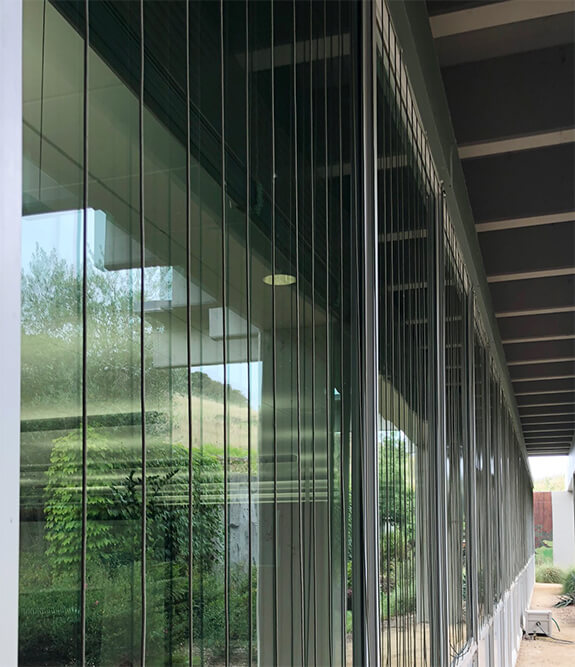
Birkenstock building retrofitted with Acopian BirdSavers. Photo by Nancy Moock
Also known as a "Zen wind curtain," Acopian BirdSavers consist of lengths of parachute cord hung vertically and spaced four inches apart in front of a window. Acopian will custom-make the BirdSavers to fit a specific window dimension, but also provides directions for those who want to craft a do-it-yourself version.
Burke brought the BirdSavers idea to Birkenstock's office manager, Nancy Moock.
"She said if the company won't pay for it, I'll pay for it out of my pocket,” Moock says. "I said, ‘No, no, no,' and I got it approved."
The company purchased the BirdSavers and put them up on most of the windows in the 22,000-square-foot building. The modification has been "99.9 percent effective," Moock says. People do ask about the strings, Moock says, "and when I tell them they're to keep birds from hitting the window, they say, 'Oh! That's great.'”
Key West International Airport, Florida
At the Key West International Airport, the push began with taxicab drivers. Cabs wait for passengers underneath two glass pedestrian overpasses. During migration, many birds, especially neotropical migrants like Northern Parulas and Prairie Warblers, would hit the glass on the overpass and fall into the roadway below, where cars would flatten them.
"The cab drivers would come in extremely upset because they'd see it happening," says Tom Sweets of the Key West Wildlife Center, a local wildlife rehabilitation center. "Most of the time when we got there [to rescue the birds], they were already run over."
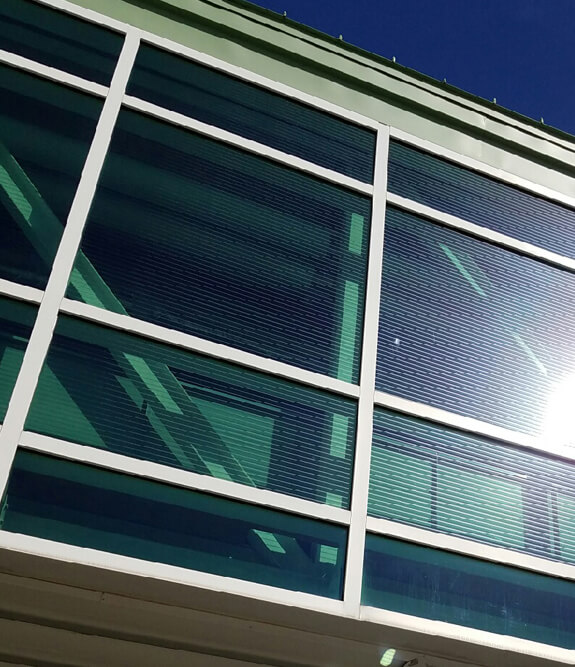
Key West Airport overpass. Photo by FloridaKeysWindowTinting.com
Staff from the Wildlife Center teamed up with the Florida Keys Audubon Society to approach the airport's management about the problem and find a solution. "Thanks to ABC's Bird-friendly Building Design booklet, we had a document in hand to show which techniques would not work (venetian blinds) and which would (striping on the glass)," says Mark Hedden, executive director of the Florida Keys Audubon Society.
Eventually they settled on Solyx Horizontal Bird Safety Film. The durable film, applied to the outside of windows, has unobtrusive gray lines that are visible to birds. Tests performed by ABC and reports from the field show that the film is highly effective at preventing window collisions.
The airport applied the film to the glass on both pedestrian overpasses. Airport Director Don DeGraw reports that the Bird Safety Film was "well worth" its cost. Sweets, meanwhile, says he has not received any calls about birds colliding with the overpasses since the modification was completed in 2016, and on his periodic checks of the roadway below he hasn't found any dead birds.
Walter E. Washington Convention Center, Washington, D.C.
This sprawling structure in the heart of the nation's capital had a similar problem with a glass-walled pedestrian overpass. Volunteers with local organization City Wildlife regularly walk several miles around downtown to collect and record birds killed in window collisions and rescue stunned birds. They soon discovered that the 2.3 million-square-foot facility's L Street pedestrian overpass alone killed an average of about 11 birds per year, including Veeries, American Redstarts, and Yellow-bellied Sapsuckers.
City Wildlife, which provides wildlife rescue and rehabilitation in the Washington area and runs the Lights Out DC program, shared the findings with the Convention Center management. The group urged the management to apply a glass treatment to remediate the problem.
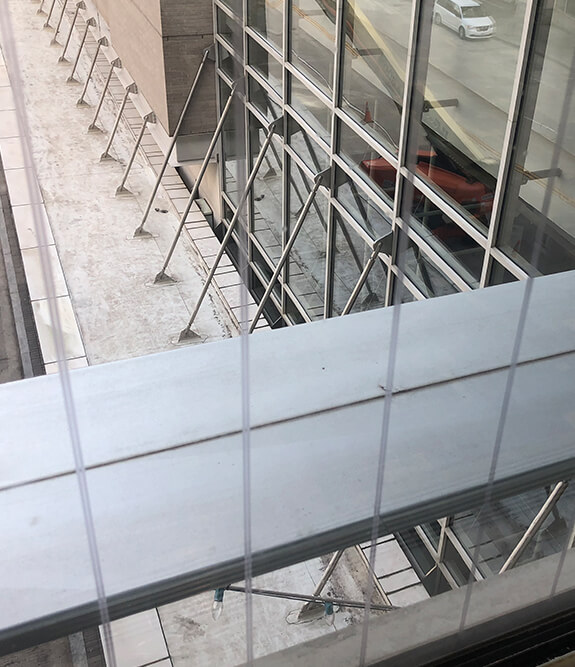
Washington, DC's Walter E. Washington Convention Center L Street overpass. Photo by Anne Lewis
The Convention Center chose Solyx Vertical Bird Safety Film. Since it was applied in the fall of 2016, there has been an 82 percent reduction in bird strikes at the overpass, says City Wildlife President Anne Lewis, but no change in frequency of strikes on other, untreated parts of the building.
The film is surprisingly unobtrusive. Soon after the Convention Center decided to purchase the Solyx film, Lewis, an architect, was attending an American Institute of Architects convention at the facility. Solyx had a vendor's booth there, and Lewis asked the company's representative when the Convention Center planned to apply the film to the overpass.
It was already installed, he told her. "I had been walking by it and not even noticing it," Lewis says.
National Renewable Energy Laboratory, Colorado
When the National Renewable Energy Laboratory (NREL) campus in Golden, Colo., saw a surge of construction roughly a decade ago, Tom Ryon, the facility's senior wildlife biologist, played an active role. Ryon anticipated that bird strikes would be a problem for some of the planned labs, bus shelters, and other structures, which featured large amounts of reflective glass. So he advocated for bird-friendly designs to be incorporated.
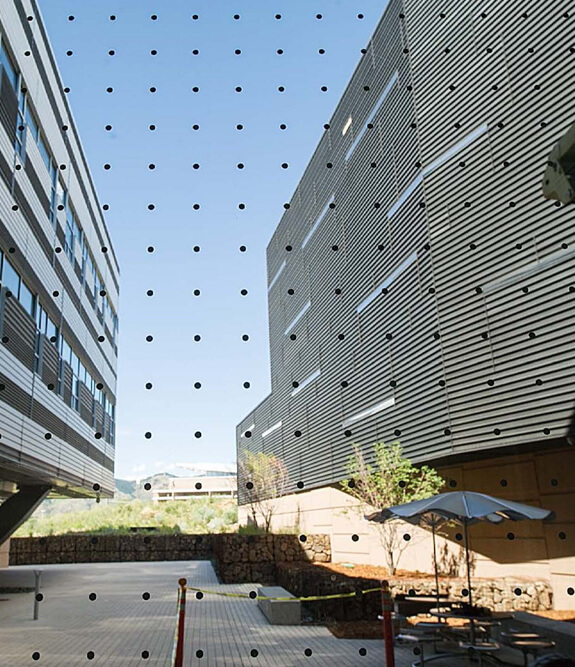
National Renewable Energy Lab building. Photo by Tom Ryon
For instance, a "fritted" glass made by Viracon was used in some new structures. Fritted glass has a ceramic pattern, usually consisting of dots or lines, fused into it. Fritting is an ancient technique that is regaining popularity because it can be used to create aesthetically pleasing effects and the reduced transparency of the glass helps keep buildings cool.
In other areas of NREL's campus, the team got creative with their bird-friendly designs. They employed a product called CollideEscape that can incorporate graphics or text into window treatments. NREL used it to decorate their bus shelters with mountain scenes and text about living with birds. NREL was even able to retrofit some buildings that proved problematic for birds, in one instance using a product called Feather Friendly, featuring a pattern of adhesive dots applied to the exterior of the glass.
Ryon monitored bird strikes at the troublesome windows before they were retrofitted and for two migration seasons afterward. He found that the number of birds killed each season dropped from 15 to 20 fatalities down to 1, or sometimes none.
Johnson Space Center, Texas
With its 1,600 acres of mostly undeveloped land near the Gulf of Mexico, NASA's Johnson Space Center is prime habitat for neotropical migrants. A handful of the center's buildings had problems with bird strikes. Some have been significant: In 2012, dozens of Indigo Buntings died in one night when an entire flock struck a window.
Matt Strausser, a wildlife biologist employed at the Space Center, says that event was a wake-up call for NASA. It wasn't only about the welfare of wildlife; the collisions also had an effect on worker morale, he says.
"People are walking into their offices where they're supposed to do good quality work, and if they have to step over five or six dead wild animals that they care about, it's not a great way to start the day," Strausser says.
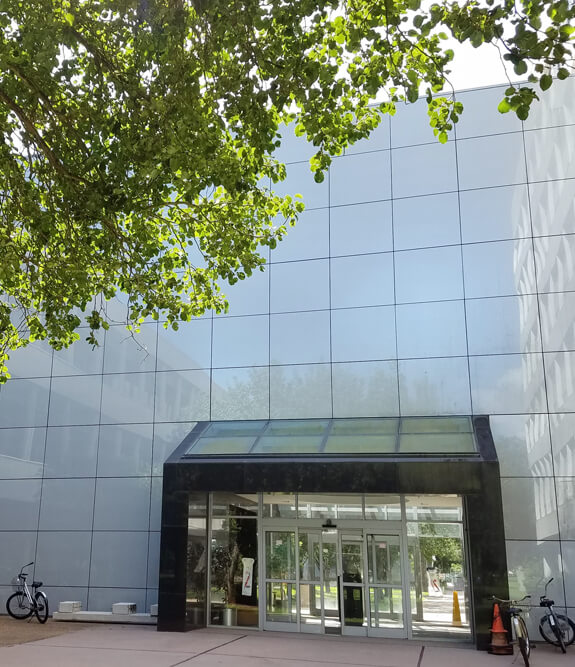
Johnson Space Center's Buildling 45. Photo by Sandy Parker
The Space Center took a number of steps to mitigate collisions. In some buildings where transparency seems to the main problem, workers are asked to close their blinds during migration season. (Although this doesn't reduce reflections, it does help prevent some collisions.) On other buildings with newer, more-reflective glass, the center has applied vinyl cutouts to break up the reflections.
The efforts have paid off. Strausser has conducted detailed monitoring of bird strikes, and since 2012, they've decreased by about 85 percent.
Closing blinds and applying bird-deterrent patterns to windows was inexpensive and "really doesn't impact our operations," Strausser says. "It was a clear win for us." And also for the birds.
Are you a homeowner, architect, developer, or just interested in preventing bird collisions? Learn more about what you can do to help.
 | Meredith Swett Walker is a science writer based in western Colorado. |





































